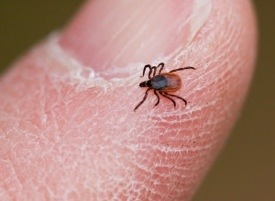
This time of year is particularly dangerous because ticks that transmit Lyme are in their hungry ‘nymph’ stage.
This time of year is particularly dangerous because ticks that transmit Lyme are in their hungry ‘nymph’ stage.
Warmer weather is here and with it comes more time spent outdoors hiking, gardening, biking and enjoying other fun activities. Unfortunately, the warm weather also encourages the emergence of ticks and increases your risk of contracting Lyme disease.
“2012 was one of the worst tick years on record and Lyme disease rates are increasing, especially in northern states,” said Debbie Siciliano, co-president of Lyme Research Alliance. “It’s important for people to take steps now to protect themselves, their families and their pets from ticks.”
The Centers of Disease Control and Prevention (CDC) has singled out Lyme disease as the most common and fastest growing vector-borne infectious disease in the nation. In 2011, more than 24,000 confirmed cases of Lyme disease were reported in the United States, with the CDC stating it believed only 10 to 12 percent of the cases have been reported.
This time of year is particularly dangerous because ticks that transmit Lyme (called Ixodes scapularis, also known as black-legged or deer ticks) are in their hungry “nymph” stage. Their tiny size (less than the head of a pin) permits them to feed—often unnoticed—for days. A bite from an infected tick can leave you with a mix of symptoms that range from fatigue and flu-like aches and pains to serious and long-term complications that affect the brain, joints, nerves, heart and muscles – all possible indications of Lyme disease.
While Lyme is the predominant tick-borne illness in the U.S., it isn’t the only one. Ticks can spread other diseases to humans, including anaplasmosis, babesiosis, ehrlichiosis, tick paralysis and tularemia. Adding to this season’s dangers is a new tick-borne infection known as borrelia miyamotoi that was discovered in humans earlier this year. The infection is transmitted by the same deer tick that transmits Lyme and shares many similarities with the disease.
“Many people who spend a lot of time outdoors know that tick bites can cause Lyme and that ticks are often found in heavily wooded areas and tall grasses, yet many don’t realize that one deer tick can infect you with more than just Lyme,” said Siciliano. “It’s important to stay vigilant to avoid being bitten by a tick.” Here are seven important tips about Lyme:
1. Lyme disease comes from ticks. While there are many different types of ticks, the black-legged ticks carry the bacteria, Borrelia burgdorferi, that causes Lyme disease. The bacterium lives inside the tick and can be transmitted when the tick attaches itself to “hosts,” such as deer, dogs, and humans and begins to feed on the host’s blood.
2. Lyme-carrying ticks are everywhere. Lyme disease is most common in the Northeast, mid-Atlantic and Great Lakes regions. It’s been reported in all 50 states (in California and other western states, the Western blacklegged tick, Ixodes pacificus, transmits Lyme and other tick-borne diseases), as well as in Washington D.C. and 50 countries around the world.
3. A bulls-eye rash is only ONE way to tell if you’ve been infected. Symptoms of Lyme can be subtler than many believe. Although most people associate Lyme with the bulls-eye-shaped “erythema migrans” (EM) rash, some people never develop it. Early stage Lyme may manifest as a mild flu-like illness with a headache, a stiff neck, or a rash that’s so pale or oddly positioned that it’s barely noticeable.
4. Keep up your landscaping. Ticks require a lot of humidity to survive and tend to stay away from well-groomed lawns that lack shade. They love to hide in plants and shrubs and are mostly found near the edge of a lawn. Mow grass regularly, remove weeds, clear leaf litter and brush, especially along the edges of the lawn, stonewalls and driveways.
5. Prevention is key. To protect yourself from ticks, wear light-colored clothing, including a long-sleeved shirt tucked into pants and long-legged pants tucked into socks. This will not only help to prevent ticks from reaching your body, it will enable you to spot ticks on your clothing. Apply a repellent containing DEET to your skin and either spray your clothing with permethrin or wear pre-treated clothing. Remember, too, that ticks crawl up; they do not jump, fly or drop from trees. “Spray tick repellent on all your shoes as ticks will latch on to your shoe laces and climb up your leg,” says Dr. Thomas Mather, director of the University of Rhode Island’s TickEncounter Resource Center.
6. Protect your pets. Check for ticks on your dog every day, especially after your dog has been outside, for a walk, or in wooded areas. Talk with your vet about the best ways to keep your pet tick-free, including whether to use a topical medication, tick collar, spray or other products.
7. Do tick checks. After spending time in a high-risk area, toss your clothes in a dryer at high heat. Ticks hate dry heat. Usually 15 minutes in a clothes dryer will kill any ticks that have attached to your clothing. Scan your body for unusual bumps that could be ticks, including the armpits, back of knees, around your waistband, the groin area, and your scalp. Take a shower and wash your hair. The longer the tick is attached, the greater the chance of transmission of disease.
Learn more about tick safety at wildsafe.org/ticks.
Tagged: black-legged, bulls-eye, CDC, deer tick, DEET, EM, erythema migrans, Ixodes scapularis, Lyme disease, permethrin, rash, Tick safety
